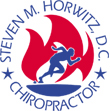 |
| Click here to access Dr. Horwitz's website, with a complete listing of classes and products. |
By Dr. Steven M. Horwitz, Maryland Director, National Strength and Conditioning Association
Posture is the first thing that needs to be corrected and must be corrected BEFORE you start a golf fitness program. For instance, if you are a “sloucher” you will never attain the flexibility you need to swing a golf club properly. In addition, you are setting yourself up for neck, shoulder, elbow, wrist, hip, and lower back injuries. In Ben Hogan's Five Lessons: The Modern Fundamentals of Golf, the entire second chapter is dedicated to stance and posture. Mr. Hogan states, “To sum things up generally, then, when you have a correct stance and correct posture, then and only then will your legs, arms and body be properly balanced and positioned to carry out their assignments during the swing.” (p. 57)
Many people get injured when they begin a fitness program because a postural assessment was not performed. You can perform this brief assessment on your own by observing your posture in the mirror and evaluating your physical capabilities with a few simple tests. First, face the mirror and look at your posture. Check for hip, shoulder, and head alignment. Then, stand to the side and check your alignment. (See below for pictorial demonstrations and exercises.)
SHOULDER ROTATION (Again, see below for pictorial demonstrations of External and Internal Rotation)
External Rotation Internal Rotation
Lie on your back and place on hand under the small of your back (your palm is facing down and the back of your hand is touching your back). Tighten your abdominal muscles and press your lower back against the back of your hand. This prevents you from arching your back (cheating!). The other arm is placed at 90° to your side and your elbow is bent to 90°. Rotate your arm backward in the direction of your head attempting to touch the back of your hand to the floor. This is called external rotation. You should be able to touch the forearms with the wrists straight.
Now, rotate your arm the other direction attempting to touch the palm to the floor. This is called internal rotation. You should be able to come close to the floor with your wrists straight.
If your external rotation is limited this will restrict your trailing side arm on your backswing and your lead side arm on your follow-through. If your internal rotation is limited this will restrict your lead arm during your backswing and your trail arm on your follow-through.
TORSO (SPINAL) ROTATION (See Below)
Sit on a chair or bench and hold a golf club or broomstick along your collarbones with your hands crossed in front of you. Turn (twist) your torso to each side while looking straight ahead; in other words, keep your nose straight ahead while your chest rotates. Do not rotate your pelvis; keep it stationary. For an unrestricted golf swing, you need at least 60° of spinal rotation. The reason you hold a club along your collarbones and do not rotate your pelvis is so you do not substitute shoulder or pelvis motion for torso rotation.
If you have restricted spinal rotation, your body will compensate somewhere else to gain rotation. This will result in a swing fault such as excessive pelvic rotation, straightening of the trail leg, or increased side bending of the spine. It can also result in injury by causing overuse of the shoulders and back pain.
After completing these tests you should have learned something about your body. You must correct the problem areas when you first start your golf fitness program. Otherwise, you will continue to foster imbalances and deficiencies in your swing mechanics and be much more susceptible to injury. A complete assessment performed by a trained professional is strongly recommended.
If you are interested in a complete assessment, please email me at golf@youcanbefit.com or call 301-622-9000.
 |
| Head Alignment -- Shoulder Alignment -- Hip Alignment |
 |
| Are your ears forward of your shoulders? Do your shoulders round forward? Is the curve in your middle back becoming increased (hump)? |
 |
| If your head is forward and your shoulders are rounded you will not be able to attain proper torso rotation or shoulder rotation during your golf swing. This is what it should look like. |
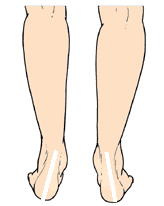 |
| Then, check your feet. Do they roll in (pronation) or roll out (supination)? Pronation -- Weight on the inside of the foot. The Achilles tendon (white line) bows out. |
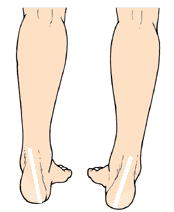 |
| Supination -- Weight on the outside of the foot. The Achilles tendon (white line) bows out. |
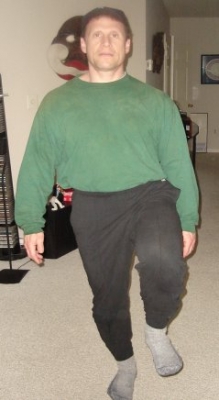 |
| How is your balance? Can you stand on each leg for 60 seconds? Stand in the corner so you can catch yourself if you lose your balance. If you are unable to balance on one leg, you will not successful in the weight transfer required in the golf swing. |
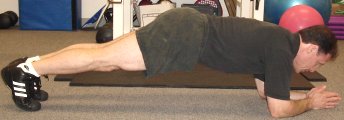 |
| How is your core strength? Can you maintain this position for 60 seconds? If you start to shake, are uneven in the hips, or have any pain, STOP! |
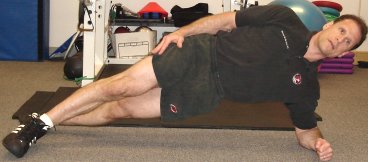 |
| Can you maintain this position for 30 seconds? If you start to shake, are unable to keep your hips elevated and forward, or have any pain, STOP! If you have poor core strength, the energy transfer from the legs to the arms will not be maximal and you will lose distance and accuracy. You will also dramatically increase your chance of lower back injury. |
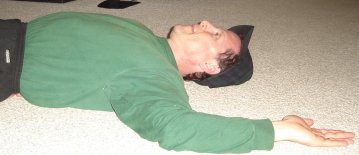 |
| Pictured here is External Rotation. |
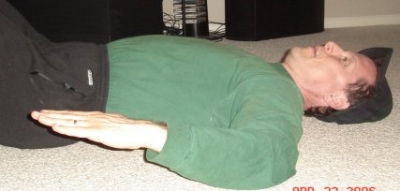 |
| Internal Rotation |
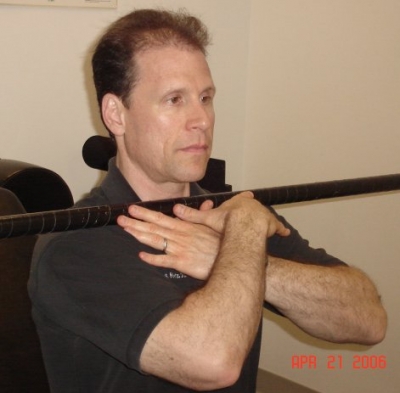 |
| Torso (Spinal) Rotation -- Start position. |
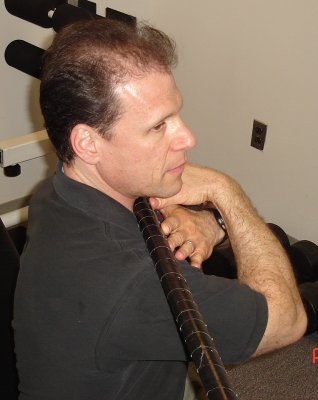 |
| Torso (Spinal) Rotation -- End Position - the measurement of your rotation is taken from the difference between the two positions. |
Details:
Dr. Steven Horwitz is certified as a Chiropractic Sports Physician, Strength and Conditioning Specialist, and a USA Weightlifting Club Coach. Dr. Horwitz was selected by the United States Olympic Committee as the sole chiropractor for the 1996 United States Olympic Team and has traveled internationally with U.S.A. Track and Field. In 1996, the Governor appointed Dr. Horwitz to the Maryland Council on Physical Fitness and served as Chairman of the council from 2002 to 2004. In 2004, Dr. Horwitz was selected as the Maryland State Director for the National Strength and Conditioning Association. He is a recipient of the Maryland Chiropractic Association's Outstanding Achievement Award and Washingtonian magazine has chosen him as one of the Washington, D.C. area's top sports medicine doctors. Dr. Horwitz is the author of the book YOU CAN BE FIT! and he competes in powerlifting and bodybuilding. He is a certified ART® and Graston Technique practitioner and practices in Silver Spring, Maryland.
Steven M. Horwitz, DC, CCSP, CSCS, USAW
Maryland Director, National Strength and Conditioning Association
Chairman, Maryland Council on Physical Fitness 2002-2004
12200 Tech Road, Suite 104
Silver Spring, MD 20904
301-622-9000
www.youcanbefit.com/golffitness.html
Note: Click on the link above to learn about Dr. Horwitz's full line of fitness classes and products.
| Related Links | Comments on this article? | |
|
Maryland National Golf Club Hollow Creek Golf Club Rocky Gap Resort PB Dye Golf Club in Ijamsville Whiskey Creek Golf Club |
E-mail Jeff Rendall, Editor: jrendall@golftheunitedstates.com |











